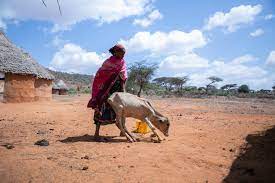WORST DROUGHT IN THE HORN OF AFRICA.

16-02-2023
The Horn of Africa is Facing its Worst Drought in More than Four Decades – Communities in the Horn of Africa are facing the threat of starvation following four consecutive failed rainy seasons in parts of Ethiopia, Kenya and Somalia, a climatic event not seen in at least 40 years.
An Unprecedented Emergency is Ravaging Drought-Affected Communities. Across the Horn of Africa, at least 36.1 million people have now been affected by the drought which began in October 2020, including 24.1 million in Ethiopia, 7.8 million in Somalia and 4.2 million in Kenya.
This represents a significant increase from July 2022 (when an estimated 19.4 million people were affected), reflecting the impact of the drought in additional geographic areas of Ethiopia, as well as the rising needs in Somalia.
At least 20.5 million people are already waking each day to high levels of acute food insecurity and rising malnutrition across Ethiopia, Kenya and Somalia, and this figure could increase to between 23 and 26 million by February 2023, according to the Food Security and Nutrition Working Group (FSNWG).
In Somalia, 7.1 million people are now acutely food insecure—including over 213,000 people in Catastrophe (IPC Phase 5)—and eight areas of the country are at risk of famine between now and February 2023, with Bay and Bakool regions of particular concern.
About 9.9 million people in Ethiopia and some 3.5 million people in Kenya are severely food insecure due to the drought. Over 8.9 million livestock—which pastoralist families rely upon for sustenance and livelihoods—have died across the region, including 3.5 million in Ethiopia, 2.4 million in Kenya and over 3 million in Somalia, according to the latest FSNWG Drought Special Report.
Food prices are spiking in many drought-affected areas, due to a combination of macro-economic challenges, below-average harvests and rising prices for food and fuel on international markets, including as a result of the war in Ukraine. In Somalia, staple food prices in drought-hit areas have surpassed the levels recorded during the 2017 drought and the 2011 famine, according to WFP’s price monitoring.